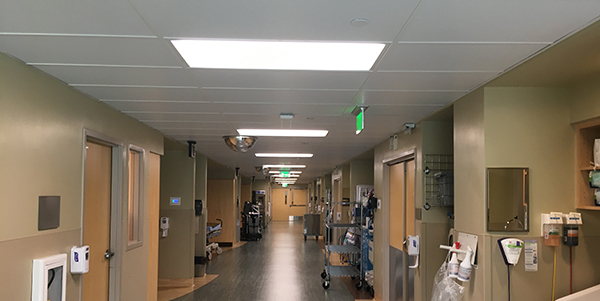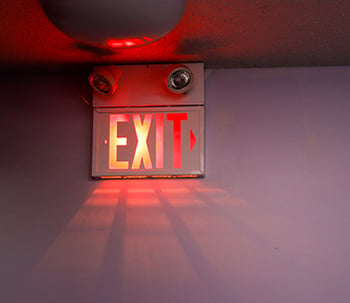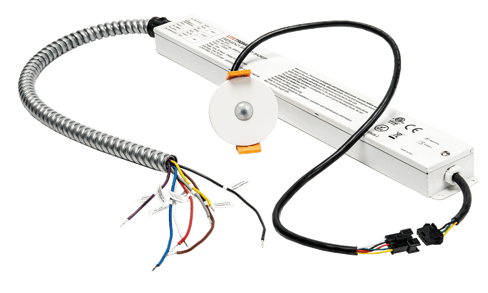
What’s the worst time to find out your commercial emergency lights aren’t working as expected?
During an emergency.
Unfortunately for many companies, the quality of their emergency lighting isn’t something they think about a whole lot. But that’s good news for you. It gives you an excellent opportunity to educate your clients on the latest emergency lighting technology — and how it can make a crucial difference when they actually need it.
Lately, emergency lighting has risen to the top of many companies’ to-do lists, and for good reason. Power outages from severe weather have doubled in the past 10 years. Not to mention we now have to consider breakdowns in our nation’s aging electricity infrastructure or interruptions from solar flares!
In short, periodic power outages are becoming a fact of life.
Meanwhile, keeping the lights on, in every sense, is essential for business continuity and employee/customer safety. Companies will be looking to you for guidance on the choice of fixtures, placement, battery life, regulations, and other specifications.
This article will help you become better-informed on emergency lighting and what options are available, so you can provide your customers with the information they need to make a smart decision. We’ll look at:
- The regulations you need to know about and why.
- What to look for when planning and choosing emergency light fixtures (standard “bug-eye” lights aren’t always the best option).
- New options you may not have considered — but that can significantly improve safety in a facility.
(Or, if you just want to take a look at our lighting products, they’re over here.)
Let’s dive in!
Commercial Emergency Lights: Who Makes and Enforces the Rules
There are several governing bodies responsible for setting codes and enforcing the requirements for emergency lighting in commercial facilities:
- The U.S.Occupational Safety and Health Administration (OSHA) ensures the safe and healthful working conditions for workers by setting and enforcing standards, and by providing training, outreach, education, and assistance. Employers must comply with all applicable OSHA rules. Proposed changes currently under review include integrating emergency lighting systems with broader emergency preparedness plans and ensuring that these systems are part of an organization’s comprehensive safety strategy.
- The National Fire Prevention Association’s (NFPA) Life Safety Code is the most widely used source for strategies to protect people based on building construction, protection, and occupancy features that minimize the effects of fire and related hazards. The 2024 NFPA 101 Life Safety Code introduces enhanced requirements for emergency egress lighting, especially in high-occupancy and healthcare facilities. It mandates that paths of egress, including corridors, stairwells, and ramps, are better illuminated to accommodate individuals with limited mobility, such as those in wheelchairs or on gurneys. And new provisions emphasize the use of LED technology for sustainability and better illumination. Regular self-testing of emergency lights is now a key component of NFPA 101, ensuring lights are always ready to function in emergencies.
- The International Building Code (IBC), developed by the International Code Council (ICC), has been adopted for use by most U.S. jurisdictions. It preserves public health and safety by providing safeguards from hazards associated with the built environment. The 2024 update prioritizes egress lighting in commercial spaces, with updates requiring higher minimum lighting levels on walking surfaces and extended illumination for critical areas like stairwells and large open spaces. The IBC now emphasizes better emergency lighting for unfamiliar occupants, addressing situations where employees and visitors might struggle to find exits during a power outage.
Aside from the codes from these “big three,” local authorities in some jurisdictions may have additional codes or regulations that must be followed. Customers whose facilities aren’t in compliance face the risk of being fined (or worse), so they will appreciate your expertise in recommending the right commercial emergency lights.
The Problem With Standard Emergency Lighting

We’re all familiar with the standard emergency light fixture (often called the “bug-eyes” light kit) that many organizations use. Mounted on the wall, it is basically just a battery unit wired into the building that provides 90 minutes of light when the power goes out. It doesn’t throw a lot of light because it doesn’t have to; the minimum one-foot candle is enough. One typical use for such a fixture is a hallway that leads to an emergency exit light over a door.
But hallways aren’t the only space you’ll find in most commercial facilities, so why should that be the only emergency lighting? For example:
- In an open-plan office, the beam from a wall-mounted light can be obstructed by cubicle walls, filing cabinets, columns, or equipment, making navigating to the exit more hazardous.
- Hospital corridors can be filled with equipment carts or IV stands and need to be navigated by people in wheelchairs or on gurneys. Add the panic effect when alarms are sounding, and safe egress gets even trickier.
- When power fails in a large space, like a warehouse, it can be hard to navigate long, tall aisles to find the closest exit.
Why Do You Need Overhead Emergency Lights?
Your goal is to make a safe environment for people in the event of an emergency and to make it as easy as possible for them to navigate their way out — in any space.
Oftentimes, the best way to accomplish that is with ceiling-mounted emergency lights or by equipping overhead lights with emergency batteries. As a result, the client gets emergency lighting that most closely resembles normal lighting conditions.
Why is this so important? It’s because not all building occupants will be familiar with the emergency egress pathways.
Think about it: In spaces like hospitals, hotels, recreational facilities or stores, visitors come and go all day long — and they don’t know the precise floor plan of the building. Odds are, they don’t even know where the floorplan maps are located. And that can be a big problem.
When Lights Go Out, Panic Can Set In
What no business wants is a lack of light to lead to a dangerous situation. When the lights go out, panic can set in quickly. Research shows that panic is triggered by a perceived threat of being trapped, closing escape routes, and a lack of help. People tend to head for the familiar, like the entrance they came in, even if safer exits are closer. And in unfamiliar environments, disorientation and “herding” behaviors can take over.
That’s exactly what happened during an ice storm in Toronto in 2013. It caused widespread power outages, affecting over 300,000 customers and leaving many buildings without light. In some cases, the failure of emergency lighting systems resulted in dangerous conditions and injuries as occupants, unable to see clearly, faced obstacles while trying to exit.
A well-designed emergency lighting scheme that illuminates paths of egress and guides people to the closest exit is the prescription to alleviate panic, disorientation, or herding. That’s why it’s so important to understand how the facility is used, and by whom, before planning out which emergency lighting solutions to recommend to your customers.
Commercial Emergency Lighting Solutions to Keep Your Customers Safe
In addition to knowing how the facility is used and by whom, you’ll need to know the lay of the land. You may be working with grid ceilings, drywall, or open ceilings with fixtures mounted to rafters.
You’ll want to have multiple options available to you to fit the LED emergency light to the needs of the customer’s space and the demands of occupant safety.
High-Bay Emergency Lighting
In high ceiling applications (greater than 25’), such as warehouses or large retail centers, customers will need more power to deliver sufficient light to the surfaces below. In those cases, an LED emergency light designed for high ceilings, like this one from Litetronics, is an ideal fit:
The unique, patent-pending design enables compatibility across a range of input voltages, from 120V to 480V without the use of a step-down transformer. Installation is simple and routine testing is made convenient via a monthly self-testing function or manual remote control. It can be mounted as high as 40’ and still deliver sufficient light below.
- Automatically switches to battery power during outages.
- Uses 30W to deliver 4,000 lumens for 90 minutes.
- Can be set to 21W for 120 minutes of emergency light at 2,800 lumens.
- 100-degree beam angle for optimal light distribution.
Emergency Backup Battery
An emergency backup battery option makes it easy to outfit a building that doesn’t already have emergency lighting. You don’t have to run wiring to new lights — just add a backup battery to an existing fixture. This gives you the flexibility to choose how many fixtures to convert while providing a better quality of emergency light.
You’ll want to have plenty of battery backup options to outfit a range of fixtures, like this LED emergency battery backup from Litetronics.

This 10W battery backup unit delivers emergency power to a wide range of Litetronics standard LED panels, troffers, strips, and retrofits. In the event of a power outage, it supplies the connected fixture with 90 minutes of light, enabling sufficient visibility for occupants to safely exit the space. The EB10 cycles through self-testing on a monthly basis, ensuring it’s always ready for action. In addition, an indicator light module displays color-coded lights that show the current operational status of the unit. The 10W models are suitable for lower ceiling spaces, and the 20W model is for high-bay fixtures.
Additional Safety Features
Look for these capabilities that reduce maintenance demands and ensure the client’s emergency lighting is always ready when needed:
Self-Testing LED Emergency Lighting
LED lights are known for their long, maintenance-free life, but testing is still vital when it comes to emergency lighting. Litetronics’ lights and batteries come with an automatic monthly self-testing function that is complemented with a status indicator light to show if it’s fully charged, in emergency mode, or about to run out of juice. Manual testing via optional remote is an add-on you may want to offer.
LED Surge Protection
Power outages aren’t the only concern for customers. Electrical storms can bring the dual threat of a power outage and a power surge — potentially damaging tens of thousands of dollars of LED lights. Choosing fixtures equipped with surge protection will ensure your emergency lighting systems are safe and can continue to provide light when needed.
Help Customers Be Prepared With the Right Commercial Emergency Lighting
No one wants to think about emergency preparedness, but everyone wants to be prepared.
That’s where you come in.
Talk with your customers about how they use the spaces in their facilities, what ceiling heights and room layout mean for LED emergency light placement, who the occupants are likely to be, and any other safety concerns they may have.
Having options in emergency lighting solutions to offer will allow you to meet their needs and give them confidence that when outages happen, everyone will be able to get out safely.
Your lighting manufacturer should be in the business of giving you these options. Our Guide to LED Lighting Manufacturers will help you choose a partner that allows you to meet your customers’ lighting needs, for every day and emergencies.




